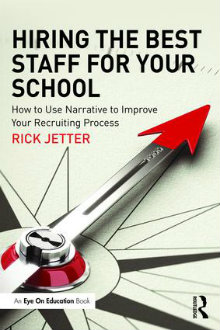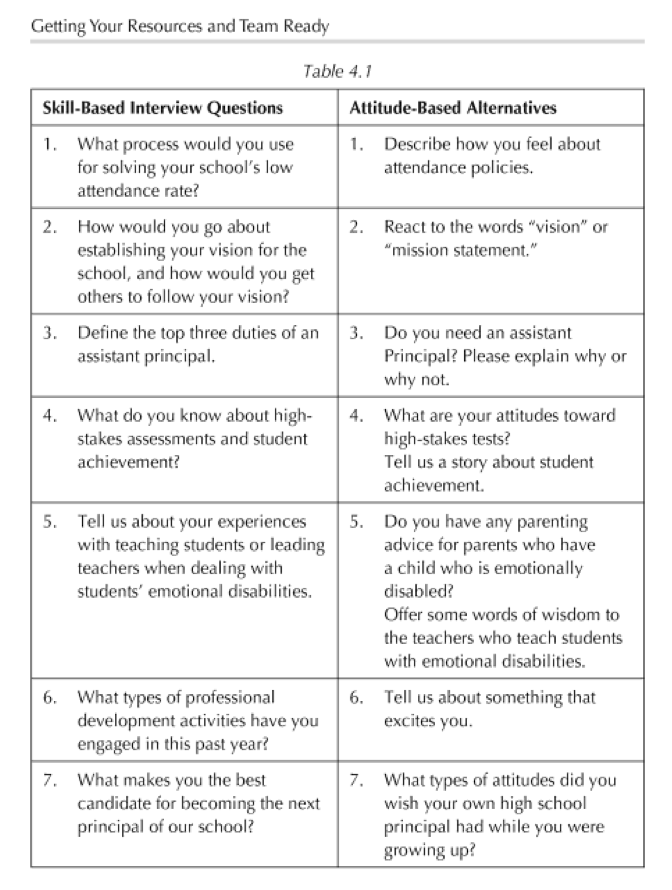Hiring the Best Staff for Your School
Hiring the Best Staff for Your School: How to Use Narrative to Improve your Recruiting Process
By Rick Jetter
(Routledge/Eye on Education, 2016 – Learn more)

It is often said that the most important decision any business makes is a new hire. All too often a person looks great on paper, scores high on the interview, but then ends up not being a good “fit” for the job.
How does this happen? What can be done to be sure the best hire is made the next time? How can you choose the best person out of 25 applicants with similar qualifications?
This book is all about how to select the best hire through the use of narratives. The author does his utmost to convince the reader that qualified, but poor hires, can be avoided by the use of narratives.
Discovering attitudes and dispositions

The book begins by introducing readers to “narrative tools” and explaining why they are exciting to use. Jetter continues on to justify why the typical application materials – the application form itself, the resume, transcripts, recommendations, and the portfolio – are important for judging the knowledge, skills and abilities but do not adequately address attitude and disposition.
Narratives in the context of this book are stories. In the hiring process, narratives are “an account through which experiences are related in response to presented story lines.” Jetter does not feel it is necessary to dissect discourse patterns or the formal structures of narratives in the book.
Instead, he wants the reader to understand and employ the potential and power of narrative theory in hiring practices. Narratives can be used to promote forward thinking and assessment of attitudes and self-reflection, giving unique insight into the individual.
Research supporting narrative theory
The requisite chapter on research supporting narrative theory and hiring practices is included, should you choose to look deeper into the subject area – or have not yet been convinced of the empirical benefits of narratives. Jetter invites the reader to skip this chapter if research and literature reviews are not your thing. However, the chapter does set the stage for appreciating narrative theory and recognizing its purpose in the educational arena.
Interview teams are encouraged to brainstorm in each of these areas: students, learning, achievement and culture. It is important to determine ahead of time the criteria that are important to assess and the desirable attitudes a candidate should possess.
A “how to” guide
The author then provides a “how to” guide for designing interview questions that mine for attitudes – not questions that will just reflect knowledge, skills, and/or abilities of the candidate. Several tables comparing traditional vs. attitude-based interview questions are included for reference.

Readers are encouraged to use real situations in their interview questions so the candidate must take a position and explain their thoughts, providing insights into attitudes that may or may not fit with your school culture.
Rubrics are provided, facilitating assessment and providing a basis for personalization to your situation. Additional narrative scenarios, accompanying rubrics and other e-resources are available for download.
Two case studies are included. The demographics are different and the stories unique. These examples provide justification of how narratives can facilitate hiring the best teacher, the best assistant principal, and the best social worker – all essential positions where attitudes and dispositions are key to making a school work. These cases have storybook endings, but don’t we all want a storybook ending in real life?
Finding the time and garnering the benefits
The book concludes with pluses, potentials, concerns and frequently asked questions about using narratives in the hiring process. Jetter also includes comments from the hiring committees discussed in the book.
It is all encouraging, as one might expect, and Jetter anticipates the main concern of all educators – the time factor – which he adequately addresses. He advises putting more effort in the front end to set criteria, write the questions appropriately, and develop the rubric, making the assessment at the end relatively easy.
Jetter even estimates the additional time required to employ the narrative process (for eight candidates) as about two hours. The bonus to the process is that you will have insight into attitudes and dispositions so you can select the best candidate for your purposes.
Reflecting on what I learned
I was on a search committee for a new registrar at our university as I was reading this book. I took notice that most questions yielded only factual information or were posed to elicit a certain answer. I found myself rewording these questions in my mind to draw out attitudes. I could see the wisdom in what the narrative approach could have done for the process as we proceeded.
Needless to say, I intend on trying the narrative method out for our next new faculty hire.
Allison Wilson is a professor in the Biological Sciences at Benedictine University. She currently is administering a Noyce Teacher Scholarship grant from the National Science Foundation to encourage students to become grades 6-12 STEM teachers. Although teaching is her priority, she served as department chair for six years and has experience in the hiring process for faculty and upper level administrators.


































Love this idea. In my district, however, we had to use the same questions for everyone which were pre-approved by the board and union, so this method would need to be sold to them.
Mary–You make an excellent point. I’ve worked with school districts on training School Boards, Administrators, and hiring teams to be able to implement a standardized way for an unorthodox approach. If the criteria is set before you activate your recruitment methods, you automatically steer clear of potential EOE issues, indeed! I’m grateful that you continued the discussion. Very grateful.
Allison–Your review is incredibly well written and insightful. I love how you apply the methods presented in the book to the Registrar position at your institution. I’ve had colleagues, even outside of education, contact me for assistance with using the methods in non-educational settings, as well. Maybe that will be my follow up book. LOL.